Variation: Biscuits for Strawberry Shortcake
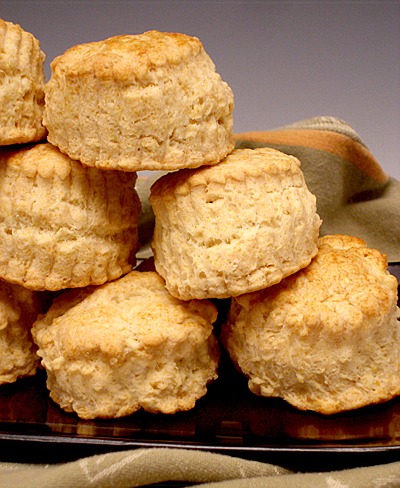
Biscuit making is as much a technique as a recipe. It's easy to follow the recipe to the letter but not have the technique needed to master making a flaky, tender biscuit. When not done right, a hard, dry hockey puck of a biscuit is the result. Making my Tender and Flaky Sweet Biscuit Recipe will help you perfect your biscuit making skills. Biscuit making takes practice and time; don't be upset if your first trials are lopsided, don't rise as high as you hoped or are dry and not flaky. But, once you have mastered the steps you will be able to male consistent, flaky and tender biscuits.
Biscuits are usually leavened with baking powder, making them part of the Quick-Bread Category. Quick-breads encompass a large family of familiar recipes — loaves, as well as muffins, scones, biscuits, pancakes, waffles, crepes and more — The name “quick” in a quick-bread's title, is derived from the fact that they are mainly leavened with baking soda and/or baking powder, both chemical leaveners. They are quick-acting and allow the bread to begin rising the moment you add the wet ingredients with the dry. On the other hand, yeasted bread requires a lengthy fermentation, measured in hours.
The most popular way to prepare biscuits is much like making pie pastry where the solid fat, such as stick butter or shortening, also known as shorteners, is “cut into” the flour and dry ingredients. This results in a flaky texture. The purpose of cutting fat into the flour is to break up the fat and expose more surface area so it can be in contact with a greater amount of flour particles.
I use this recipe in my Mini Skillet Strawberry Shortcakes.
QUICK-BREAD RECIPE HELP
KELLY SAYS: “Prettiest and flakiest biscuit I ever made. It's a GREAT recipe!”
INGREDIENTS
1/2 cup (1 stick) unsalted butter, cold or vegetable shortening, room temperature.
2 cups unbleached all-purpose flour (spoon into measuring cup and level to rim)
3 tablespoons granulated sugar, plus extra for sprinkling on the tops of the biscuits
4 teaspoons baking powder
1/2 teaspoon salt
1/2 cup (or more if needed) heavy cream, cream, half and half or whole milk, cold or plus extra for brushing the tops of the biscuits for a golden brown color.
NOTE: Brushing instead with a thin coat of melted butter promotes even darker browning.
INSTRUCTIONS
1. Position oven rack in the center of the oven and preheat the oven to 425 degrees F. Set aside a clean, ungreased baking sheet or line with parchment paper.
2. In a medium bowl blend dry ingredients: combine the flour, sugar, baking powder and salt. Set aside.
Sarah Says: “Cutting in” the shortening or fat means cutting the cold fat into small bits in the flour and dry ingredients until it resembles small peas.
3. Cut cold stick butter into small, evenly sized pieces and refrigerate it for 30 minutes or freeze it for 10 minutes until cold.
If using shortening, use tablespoon size amounts. There's no need to chill it beforehand.
Sprinkle the chilled butter over the flour and toss with a fork. Cut the butter into the dry ingredients with a Bench Scraper, two knifes (in a scissor motion) or a pastry blender until the butter pieces are the size of small peas. With your fingertips press the butter into the flour so it forms large flakes. Continue until the flour looks shaggy and the butter pieces are evenly distributed throughout. You should have pea size and small size lumps of fat. If the butter starts to get greasy, it is melting and getting too soft, chill the mixture for 15 to 20 minutes before proceeding.
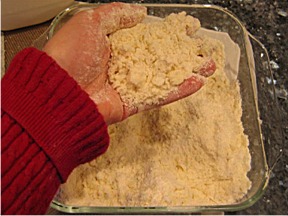
4. Drizzle a small amount of the heavy cream over the dry ingredients while at the same time tossing with a fork. Reach down into the bottom of the bowl with the fork to work in the liquid before adding more. Repeat until the dough starts to look clumped together and sticky. You may need more or less milk; it's ok if you do.
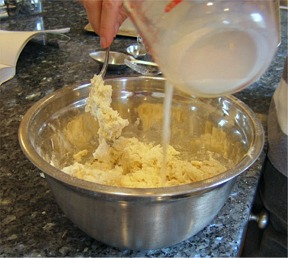
Stop mixing when the dough reaches this look. You may not need all of the liquid.
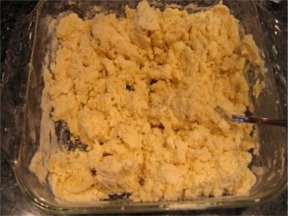
5. Turn the dough out onto an unfloured work surface or silpat mat. Gently press the dough together with your fingertips. When you gather the dough together, it will barely stick together. Knead the dough so it comes together better, but not so much that the dough becomes too damp. I didn't add any flour to the work surface; it fell out of the dough during kneading.
6. Knead the dough 30 times, no more: kneading or manipulation of the dough, which involves mixing, kneading and folding into layers of fat and flour, gives a layered and flaky crumb. The dough must be kneaded sufficiently to develop enough gluten to obtain the desired flaky texture.
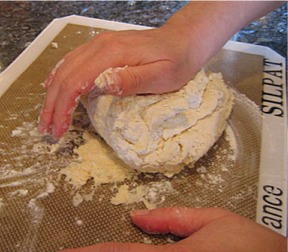
To knead: First, bring the dough together with both hands by pressing it together. Then, fold dough in half and press. Do not add more flour to the kneading surface. As you knead, turn the dough a quarter turn each time. Repeat previous step and this one together, 30 times. The dough should be soft and slightly elastic, but not sticky or dry. Be careful — overkneading toughens the biscuits.
7. After the kneading, the dough will be cohesive and slightly bumpy. Pat into a ball. If I cut a cross section of the ball, it would have flaky layers inside.
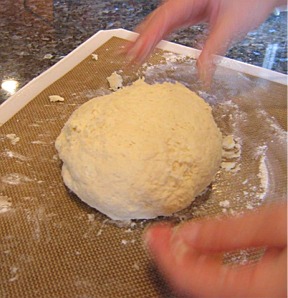
8. Pat or roll the dough to about a 1/2-inch thickness for tea biscuits (3/4-inch for shortcakes). Cut dough with a 3-inch cutter: Use one with a sharp edge to make a clean cut. Start at one edge of the dough and keep the cuts close to each other to prevent a lot of scraps. (Scraps do not rise as high as the original dough does). Cut straight through the dough, don't twist. This helps to make a high rising biscuit because it doesn't seal the edges of the biscuit from the twisting action, allowing it to rise freely. Remove scraps.
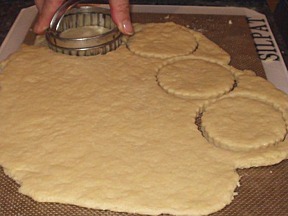
9. Lift cut-out biscuit dough gently with your fingertips, trying not to distort the circle and place on an UNGREASED or parchment paper lined baking sheet. Place close together for a softer side and for a crustier biscuit place 1- to 1 1/2 inches apart (for 1-inch thick). Some biscuits will get distorted in shape if they are too close together. Try not to move the biscuit dough around too much, as you don't want to end up pinching the sides of the dough together when you do, resulting in compact, less tender biscuits. Brush the tops with milk and sprinkle with sugar.
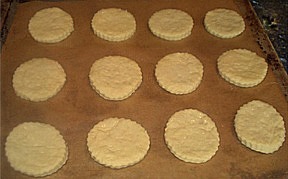
If you have scraps, stack them one on top of each other and roll with a rolling pin. They will not rise as high as the original biscuits, but they will be good.
10. Place biscuits in oven and immediately reduce the oven heat to 350 degrees F. Bake for 12 – 15 minutes. Bake until the tops are just lightly browned (top photo) and the bottoms (bottom of lower photo) are a slightly darker color. The biscuits should triple in height and rise to about 1 1/2-inches. Remove from the oven and let cool to room temperature on a wire cake rack.
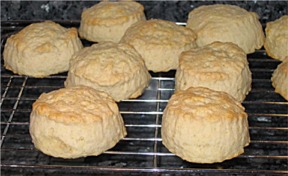
The biscuits should be lightly browned on the bottom.
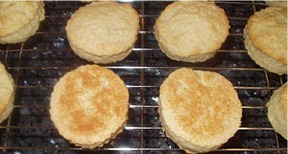
VARIATION
To make biscuits for Strawberry Shortcake:
Pat the pastry dough into a square, 6- x 6-inches, preferably 3/4-inch thick. Cut the square into quarters. Place biscuits on an UNGREASED baking sheet and bake for about 15 – 20 minutes, until golden brown around the edges. Remove and let cool on a wire cake rack.
STORAGE
Biscuits stale quickly, so store any leftovers as soon as they cool in an airtight container at room temperature for up to 1 day. They will be harder than the day before. Reheat by placing them on an ungreased cookie sheet in a 350 degree oven for about 10 minutes; watch carefully so they don't burn.
Biscuits can be frozen, either partially or fully baked for no longer than 2 months. To freeze fully baked biscuits, cool them to room temperature and immediately place in plastic freezer bags, pushing out as much air as possible. To thaw, let biscuits sit at room temperature about one hour, unwrap and reheat in an oven.
To freeze partially baked biscuits, make the dough and bake only until the biscuit has risen but isn't beginning to color. Remove from the oven and cool, then wrap and freeze. When you're ready to bake, preheat the oven to 375 degrees F and finish baking the biscuits until the tops are golden.
To freeze biscuit dough, prepare and cut the biscuits according to the recipe directions. However, be aware that they won't rise as high when baked because the leaveners become weaker the longer they are stored. Freeze uncovered on a cookie sheet for about 1 to 2 hours, then place in freezer bags or stack in an airtight container with a piece of waxed paper between each biscuit. Cover and freeze for up to four weeks. Thaw biscuits unwrapped at room temperature, about an hour. Bake in a preheated 425 degrees F oven for about 20 to 25 minutes.
Adapted from Baking 9-1-1, by Sarah Phillips, Simon and Schuster, 2003.


